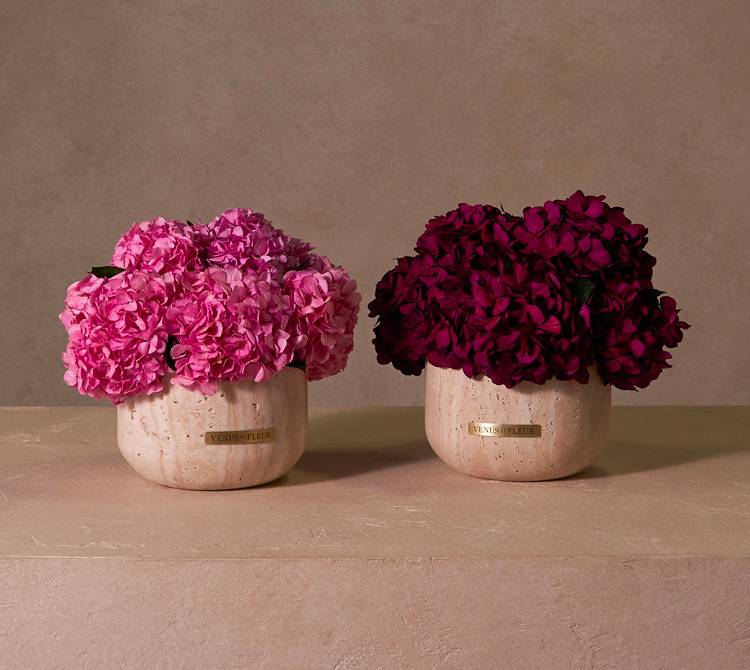


Hydrangeas imbue a light and airy presence that evokes the essence of carefree summer days. Their presence enhances the aesthetic of any space and infuses a refreshing summer charm into your home decor. Whether you seek to elevate the ambiance of a summer soirée or cultivate a tranquil oasis within your living space, hydrangeas provide that extra touch of brilliance you desire.
Join us as we unveil the origin, meaning, and symbolism of the graceful perennial flower known as the hydrangea.
Hydrangeas have a rich history in Japanese culture, rooted in a poignant legend. According to the tale, a Japanese emperor, burdened with regret over abandoning his beloved, offered her numerous blue Ajisai (Japanese hydrangea) flowers as a sincere expression of remorse.
However, during the era of feudal Japan, the warrior class regarded the Ajisai blossoms with caution. The warriors' apprehension stemmed from the flowers' kaleidoscope of changing colors. Known as Nanahenge, meaning "seven transformations," hydrangea symbolized their extraordinary ability to transition through multiple hues over time, adding an air of mystique to their allure.

While the origins of this plant can be traced back to Japan, where the hydrangea remained concealed within secret gardens for centuries, its intriguing history extends far beyond those borders. Ancient hydrangea fossils dating back 40-65 million years have been uncovered in North America, indicating the plant's presence in the region long before its official recognition.
Native Americans deeply appreciated hydrangeas, utilizing its root and rhizomes for diverse medicinal purposes, specifically the kidney and bladder. They revered hydrangeas for their beauty, incorporating them into ceremonies and using their flowers for natural dyes. Hydrangeas held spiritual significance as a connection to nature and their sacred rituals.
During the Victorian era, hydrangeas were regarded as prideful plants, symbolizing boastfulness, bragging, and vanity. This perception stemmed from their abundant blooms and scarce seeds, which led people to view them as lavish displays. Hydrangeas were rarely given as gifts or displayed as fresh-cut flower decor during that period.
In Korean culture, hydrangeas are associated with perseverance and resilience. Today their brilliance is celebrated yearly at the Hydrangea Flower Cultural Festival at the Busan Taejongsa Temple inside the Taejongdae Park.
The hydrangea encompasses a broad spectrum of meanings, ranging from abundance, heartfelt emotion, gratitude, and boastfulness, with each interpretation rooted in cultural history, beliefs, and narratives. In Japanese culture, the association with apologies originates from a specific legend surrounding the flower.
During the Victorian era, hydrangeas were regarded negatively, symbolizing traits such as boastfulness, bragging, and vanity. This perception stemmed from their remarkable display of flowers but limited seed production. Additionally, they were often bestowed upon individuals who rejected romantic advances, implying their perceived coldness or frigidity.
Hydrangeas have a contrasting reputation, embodying positive and negative connotations within various cultural contexts.
The symbolism of hydrangeas is intricately tied to the colors of their blossoms, with each hue conveying its own unique message. Exuding the aura of gratitude, abundance, and grace, Venus et Fleur® eternity® hydrangeas offer a serene tribute to nature, captivating all who behold their exquisite beauty. Consider the following hydrangea colors when choosing the perfect blooms.
White hydrangeas symbolize purity, innocence, and honor; their graceful blooms are an ode to the delicate essence of nature. The ethereal blooms of white hydrangea are fashioned as exquisite gifts, befitting summer weddings and stylish home decor.
In ancient Japanese culture, blue hydrangea is imbued with the symbolism of apology and remorse. Today, the elegant presence of blue hydrangeas gracefully signifies serenity and gratitude. Blue hydrangea flowers unfurl as the perfect hostess gift, a graceful token of appreciation.
The word "hydrangea" originates from the fusion of two Greek roots, 'hydro' meaning water, and 'angeion' meaning vessel. This combined term loosely translates to "water vessel," alluding to the plant's affinity for moisture and remarkable ability to absorb and retain water.
Inspired by the everlasting beauty of hydrangeas, our eternity hydrangeas are preserved to mirror their allure without needing water. Venus et Fleur eternity flowers are real flowers that last a year. They require no water or maintenance, making them a truly unique and cherished addition to your home decor or a thoughtful gift.
The graceful beauty and versatility of hydrangeas continue to inspire creative expressions in various design aspects. Originating in Asia and transcending cultures and time, this flower has made a timeless impression on our collective consciousness. The enchanting array of colors, from pure white to shades of blue and pink, evokes emotions of purity, serenity, and love, making it a versatile floral choice for expressing profound sentiments.
Whether adorning a summer wedding, brightening your home decor, or serving as a token of appreciation, hydrangeas possess inherent allure. Like poetry set in motion, their blossoms remind us to cherish life’s fleeting moments and discover solace in the delicate marvels surrounding us.
Discover eternity hydrangeas in the garden of eternity flowers at Venus et Fleur.
Sources:
Hydrangea | Brittanica
Hydrangeas | Farmer's Almanac
Japanese Hydrangea | Japan Guide
Hydrangea (Ajisai) Season in Japan 2023 | Kyuhoshi
Florissant Fossil Beds | National Park Service
Fossil Plants | University of California
Taejongdae Park's Forest | Visit Busan